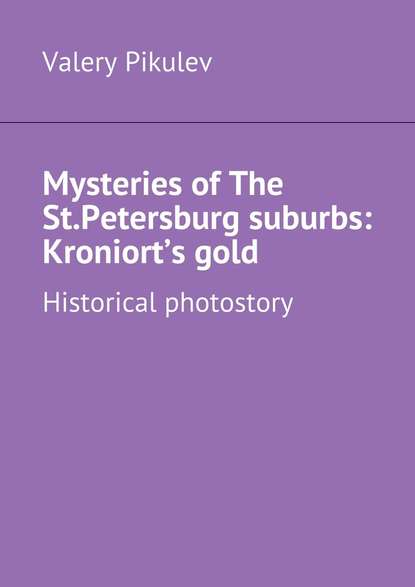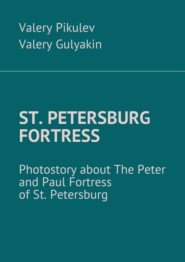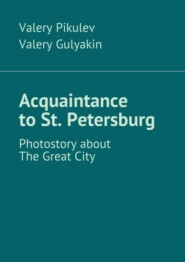По всем вопросам обращайтесь на: info@litportal.ru
(©) 2003-2024.
✖
Mysteries of The St.Petersburg suburbs: Kroniort’s gold. Historical photostory
Настройки чтения
Размер шрифта
Высота строк
Поля
Bewitching views of the park
The oak veteran twisted by the Baltik winds, but not broken!
The burden of prolonged war has concerned also Sestroretsk, having for many years defined his destiny. In the summer of 1721 at the dam which has formed the lake the Sestroretsk Flood (then and the settlement began to be called Sestroretsk), under the imperial decree, have begun to build small-arms factory which cars water from the lake had to set in motion. It directed construction (from the moment of the basis and till 1723) the colonel Wilhelm of De-Gеnnin ordering before the Olonets plants. After Gennin recalled on the Siberian plants, construction was continued by the colonel Matvei Vyrubov. On January 27, 1724 the plant has been solemnly open.
Production of the plant, – guns (a close formation quickly captivated the factory yard), mushketona, guns, sabers, broadswords, swords … – right there arrived on arms of the Fleet and Army, – now Imperial (Peter I’s construction in a rank of the Emperor of Russia has happened in St. Petersburg, in Trinity Cathedral on the square of the same name, after victorious completion of Northern war, in October, 1721). At the plant also the huge amount of gunpowder was made.
The Sestroretsk small-arms factory originally consisted of two tens shops (“weapon factories”) which machines were set in motion from twenty eight water wheels, and on technical equipment didn’t know to itself equal in Europe of that time. The wooden Peter and Paul church also has been built to his territories.
And one more worthy event 1721 is memorable for Sestroretsk! – test on the lake the Sestroretsk Flood of the first-ever prototype of the submarine: the “secret vessel” designed and constructed by the peasant Efim Nikonov of boards brass plates, iron hoops and skin. Tests were carried out in the presence of Peter.
Here she, first-ever submarine! (Historical reconstruction)
Here, on this place, the boat was also tested
At the initiative of Sestroretsk submariners this place and an event have been immortalized in 2000 by laying of a small wooden chapel of the Prelate Nicholas The Wonderworker to which base capsules with the earth taken from all places of basing and construction of submarines of Russia have been put: from St. Petersburg, Kronshchtadt, Sevastopol, the Cervine lip, Vidyaev, Liinakhamari, Gremikhi, Sormovo, Komsomolsk-on-Amur, Severodvinsk, Fishing (Kamchatka), Magadan, Gadzhiyev and San Diego (place of burial of a part of crew of the boat K-129 which was lost in 1968 in the Pacific Ocean).
Chapel of the Prelate Nicholas The Wonderworker
(view from the southwest)
Type of a chapel from the southeast
Here, nearby, also the temple in honor of Saint Apostles Peter and Pavel towers. In the territory of the temple memorial plates with the mournful list of the sunk submarines, and in the temple – the computerized information display with surnames of all died submariners are established. Consecration of the space for construction of the temple has taken place in July, 2002. Construction has dragged on for many years and has been complete only in 2009.
Type of Church of the Saint Apostles Peter and Paul from the lake
The temple, as if the ship, in the sea of greens
Wall with the mournful list of the lost submarines
We will approach closer…
Time went, also Sestroretsk changed. All the 17th century the city developed as the subsidiary territory of Small-arms factory: importance of the plant increased – also the status of the city rose. So, with opening and the beginning of development of deposits of marsh ore to Dibune-bolote, near the Black small river, in 1735 (for what at the grange “Aspen grove” the Chernorechensky iron-works have been constructed), workers-metalworkers have been sent to Sestroretsk from every quarter of Russia, and the city has considerably grown. It is interesting that the Sestroretsk plant used local metal more than fifty years!
The Sestroretsk plant was known not only the magnificent weapon. Under the special decree of the empress Elizabeth Petrovna in 1754 at the plant began to mint a copper coin (from unusable guns); and “The monetary expedition” has been created from the workshops making stamping. Till 1766 it has been released copper coins for two million rubles. There were also other orders: openwork lattices for bridges of Tsarskoye Selo, the well-known “Golshtinsky globe” (that nowadays in Cabinet of curiosities, however, restored after the fire in 1749), silver cancer for remains of the Saint Blessed prince Alexander Nevsky (that in the Hermitage), hours for Peter and Paul Cathedral (weight of 55,5 poods), from copper and cast iron.
There was also quite strange order which has nearly laid the foundation of an era of own Sestroretsk ruble: have charged to the plant stamping of ruble coins in weight two and a half pounds! However, have stopped on batch, – copper coins in kilogram the weight of circulation haven’t received, – right there the become numismatical rarity. Collectors still call this money “A Sestroretsk coin”.
Running forward, it is possible to note that at the World Fair in Paris of 1867 the Sestroretsk small-arms factory has received a bronze medal as the weapon production, best and most modern in Europe!
At the beginning of the 19th century Sestroretsk becomes the “border” city again. How did it happen?
I will remind that in September, 1721 the Nishtadtsky world which has topped a victory of Russia in Northern war has returned to the Empire her primordial lands (Vyborg also was their part) – the territory exceeding on squares Belgium and Holland, combined! Thus, all lands of the Karelian Isthmus were a part of the Russian Empire. Moreover, as a result of the last in the history of the Russian-Swedish (Findyandskaya) war of 1808—1809, all Finland also was a part of the Russian Empire (as the Grand duchy Finnish) that has been fixed by the Fridrikhsgamsky peace treaty. At the same time the “administrative” border of Finland with other part of the Russian Empire passed to the northwest from Vyborg which, wasn’t a part of the Finnish principality. However, the Russian emperor Alexander I, in purely administrative purposes, has attributed to Finland the earth of the Karelian Isthmus, up to St. Petersburg (1811). And since then the internal (administrative) border between the Grand duchy Finnish and other part of the Russian Empire passed down the river to the Sister; and Sestroretsk became kind of “border-zone” again.
And further it has historically developed so. – In December, 1917 Lenin, “having granted” to Finland independence, “he has forgotten” to take back the earth of the Karelian Isthmus, attributed to her by Alexander I in purely administrative order. In March, 1940, as a result of completion of war with Finland, the Soviet Union has eliminated historical injustice, having returned these primordial lands – the Karelian Isthmus. (And in the 2014th, as we know, Russia has returned also the Crimea!).
Crimea… Crimean war. For some reason to us this “East war” of 1853 – 1856, shameful for Russia, – the war which has specified once great empire her true (and not the first!) among the European powers there is a place, – is presented as the local military conflict between France (in the union with England) and Russia because of the Crimea.
Actually it was the Second (after war with Napoleon) the world war of the XIX century which has captured almost all Globe: The Russian Empire, the North American United States, Ethiopia – on the one hand, and Britain, France, the Ottoman Empire, Sardinian kingdom, Austria (and with assistance of Prussia) – with another! Fighting in this war was developed not only in the Crimea, but also in the Caucasus, in the Danube principalities, at the Black, Azov, White, Barentsovy, Baltic seas… and on Kamchatka! This war and Sestroretsk hasn’t avoided.
Here when the Sister the earth strengthenings built even during war with Sweden in 1788 were necessary for the city on the river! They also have helped Sestroretsk to sustain bombing of the Anglo-French fleet in June, 1854.
The earth strengthenings built even during war with Sweden in 1788
Natural coastal strengthenings
Defense of St. Petersburg lasted the whole year. On June 14, 1854 the Anglo-French squadron has approached Sestroretsk for the purpose of his capture and has undertaken firing of strengthenings in the Dubkovsky cape. However, thanks to countermeasures from the Russian side, allies couldn’t land a landing.
Here, on the Dubkovsky cape, in June, 1854 the Anglo-French squadron
It tried to land a landing
Have prevented to take Sestroretsk to the enemy not only the earth shaft and strengthenings built in 1788 for protection against Swedes. The special role in defense of the city was played by the sea mines invented by the father of the founder of the well-known award – Emmanuil Nobel, living at that time with sons in St. Petersburg and founded firm “E. Nobel and sons”. – “The Finnish gulf literally teems with these damned mines…” – the angry admiral of allies Napye has thrown.
In the memory of these drama events, in 1858 in the park the chapel in honor of the Prelate Nikolay and Saint Apostles of Peter and Pavel has been built… Destroyed after 1920, nowadays it is restored again.
Вы ознакомились с фрагментом книги.
Приобретайте полный текст книги у нашего партнера:
Приобретайте полный текст книги у нашего партнера:











